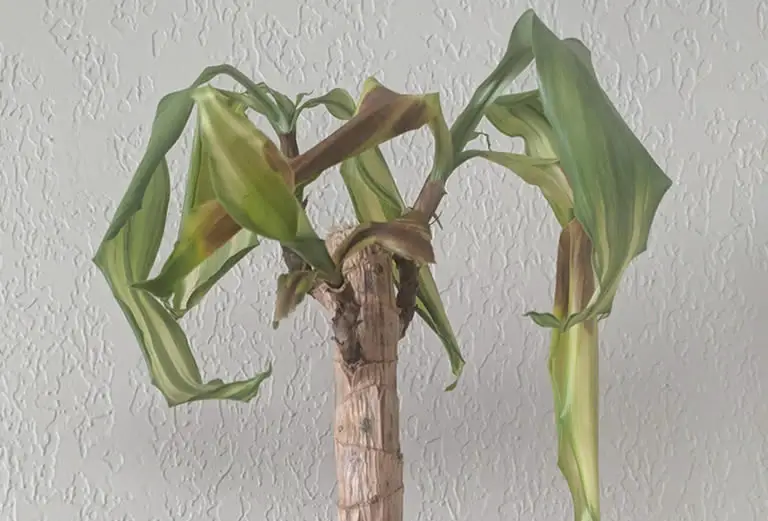Dracaena are hardy plants. Popular dracaena, like the corn plant and dragon tree, are easy-care plants that require much less care than many other popular houseplants. However, when you get a dracaena’s basic care needs wrong it can be disastrous for the plant.
In this article I will show you how to quickly identify the cause of fatal problem with your dracaena and give you the key action steps you need to take to fix the problem before you lose your plant.
Table of Contents
- The 5 common reasons dracaena die
- How to save a dying dracaena plant
- First identify the cause of the distress & then you can fix it
- 1. Incorrect care – five care mistakes to avoid
- 2. Overwatering will cause root rot – a deadly condition that will kill your plant if untreated
- 3. Disease, if left untreated, will kill dracaena
- 4. Pests will eat the life from your dracaena
- 5. Old age – death comes to us all
- The same 5 common problems also cause dracaena leaves to fall off
The 5 common reasons dracaena die
Dracaena is a succulent that is very popular as a houseplant. As an easy-care plant dracaena requires much less attention and care than other popular houseplants. But, when you get this care wrong the plant can suffer badly and even die.
There are also other problems that can can occur that are unrelated to the care of the plant but which can also cause plant death such as pests and disease. I will cover all of them.
If you have a dracaena that is showing distress and verging on the point of death then you must act quickly.
The first step you must take is to identify the cause at the back of the problem so that you can administer the correct the cure.
Root rot is the most common cause of a dying dracaena but not the only one.
There are a number of reasons your dracaena could be dying, from old age to incorrect care and from pest infestation to disease. Once you identify the cause you can apply the specific cure and in most cases you will be able to save your plant.
The 5 main causes of dracaena death:
- Incorrect care routine.
- Overwatering.
- Diseases.
- Pests.
- Old age.
In the section below, on treating your plant, I will outline how to identify which cause is responsible for your dracaena problems and which fix you need to apply.
How to save a dying dracaena plant
So how do you save a dracaena that is on the verge of death?
You can save a dying dracaena plant by identifying the cause of its problem through visual inspection of both the foliage and the rootball.
There will be clear signs in both that point to the cause. Only by knowing the specific cause can you administer the correct cure.
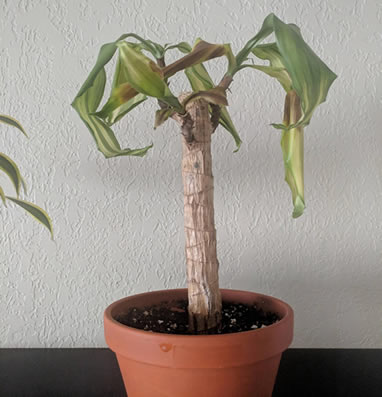
By inspecting the plant and looking for key signs you can quickly know which cure to apply to revive your plant.
What do you need to look for to revive your dracaena? Let’s look at that now.
How to bring your dracaena back to life
So how do you bring a dracaena that is ailing back to full vitality?
- To bring a dracaena back to life you must first identify what the cause of the problem is.
- The main causes for dracaena problems are: 5 different aspects associated with incorrect care; pest infestation; disease; root rot.
- Once you know the cause you can then apply the fix and in most cases you will save your plant.
In order to properly identify the cause for your ailing plant read this article in its entirety. Even if you think you have identified the problem immediately be sure to look at the other potential causes outlined as your specific plant may be suffering from more than one.
Once you correctly diagnose what is causing your dracaena to weaken and become sickly you will then be able to quickly give the plant the exact care and attention it needs to recover.
First identify the cause of the distress & then you can fix it
Let’s now look at each of the 5 main causes behind the death of dracaena plants and the fixes we can apply to the plant before it reaches the point of being unsaveable.
Once you have clearly identified which one of the following things is causing the problem with your dracaena it is just a matter of applying the fix that I have outlined below.
1. Incorrect care – five care mistakes to avoid
I have decided to tackle the topic of incorrect care first because it involves several different care aspects, each of which can cause the death of a dracaena independently of the others.
The incorrect care steps are:
- Incorrect temperature or temperature swings.
- Lack of light.
- Overfertilization.
- Allowing the plant to become rootbound.
- Overwatering.
Let’s look at each of the above points in turn.
Temperature fluctuations lead to temperature stress
Temperature stress is more likely to cause leaf loss than the actual death of your dracaena but if the effects are prolonged and drastic enough both incorrect temperature ranges and sudden spikes or dips in temperature can kill your plant.
Dracaena requires consistent temperatures in a range between 65°F – 75°F. As most homes are kept around 70°F year-round dracaena houseplants rarely experience temperature stress. However, if your home experiences prolonged temperatures outside the aforementioned range it can cause harm to your plant.
A much more likely cause for major distress in a dracaena and even death, as far as temperature goes, is sudden and dramatic shifts in temperature.
Sudden spikes or sudden dips in temperature can shock a dracaena and cause it to shed its leaves. If these temperature swings continue, the regular shocks can cause the plant to die.
What causes temperature swings?
Placing your dracaena close to the front or back door of your home where outside temperatures can invade that area can cause spikes or dips in temperature, depending on the season.
Likewise, placing your dracaena close to heating vents or radiators can cause sudden spikes in temperature, while placing it beside fridge and freezer doors can cause sudden dips in temperature.
To avoid temperature shock and its effects you must ensure you place your dracaena somewhere that has consistently warm temperatures in the plant’s preferred range.
Also be aware that, although it is unlikely to cause death, low humidity can also be a problem for dracaena. Be sure to use a small plant humidifier as they work really well with these succulents and you can pick up a really good one for less than 20 bucks.
After you treat your plant for whichever cause you identify I strongly advise you to use a humidifier, at least until the plant fully recovers.
Lack of light will stunt dracaena growth and may even kill the plant
Dracaena can get by, and grow quite well, in only 4 hours of indirect light per day (though I prefer giving them at least 6 hours) but without that light a dracaena will suffer and may eventually die.
More often than not a dracaena that is getting insufficient light will look like it is dying when in fact it is merely unable to feed its foliage due to poor photosynthesis caused by low light conditions.
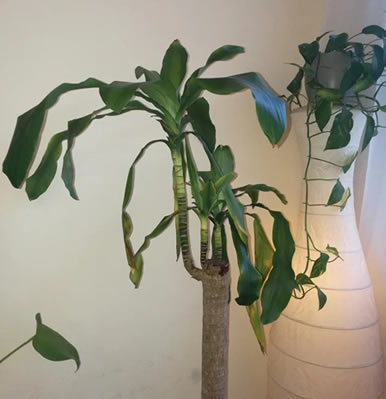
When a plant has reduced resources it will protect itself by stopping what little resources it has from reaching the outer parts of the plant.
This means your plant will look sickly. The leaves will wilt and often fade in color. The plant is not actually dying but is merely suffering from a lack of resources. When you relocate the plant to an area with sufficient light the plant will shows signs of recovery very quickly though you will have to wait for new leaf growth before it regains its previous luster.
Do not cut away the discolored leaves! Allow the plant to recover naturally.
Ensure your plant is placed in a location that gets good strong indirect light (direct sunlight is just as bad for a dracaena as no light) for at least 4 hours per day. If your want the plant to recovery quickly, or you do not have a suitable spot with enough light, consider using a grow light.
See our guide that covers all dracaena light requirements.
Overfertilization can lead to dracaena death
Being a succulent dracaena requires very little fertilization and only needs feeding during its growth stages before it blooms (if your plant does bloom).
Many houseplant owners make the mistake of using the same fertilizer, in the same quantities, on their succulents that they use on their non-succulent houseplants. This is a major, and sometimes deadly, mistake to make.
I always use a good quality liquid succulent fertilizer for all types of succulents purely to avoid any potential problems that can arise from overfeeding these plants. Succulent feeds are formulated specifically for plants that require much less fertilization than other plants.
If you do decide to use regular houseplant fertilizer be sure to dilute it to half strength before feeding your dracaena. Never use full strength regular fertilizer on any succulent.
To avoid overfertilization even when using a succulent feed I advise you to only feed your dracaena once a month during the active growing phase of spring and summer.
Rootbound dracaena will starve of nutrition and oxygen
When a dracaena becomes rootbound it is much more susceptible to stress. Stress can kill the plant.
Excess roots can also quickly drain the soil of the nutrients that the plant needs to sustain life.
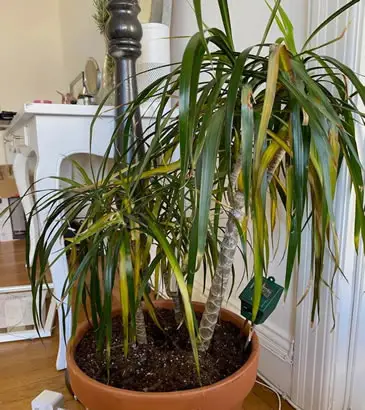
Although one of the less likely causes of plant death it is still possible that a rootbound plant can die, so you should check the rootball of the dracaena.
A dracaena that is rootbound can also be the cause of a lack of growth in your plant as outlined in our article on dracaena not growing.
2. Overwatering will cause root rot – a deadly condition that will kill your plant if untreated
Root rot is a very serious condition for any plant. With succulents, like dracaena, it is often a quickly executed death sentence.
In almost every case of root rot that I have treated the cause was overwatering. Occasionally I have found root on plants that was caused by a fungal infection (which we will look at next) but in 9 times out of 10 overwatering will be the culprit.
Although there will be signs of root rot in the foliage, and there may also be signs of decay at the base of the stem, the only way to be certain your plant has this serious problem is to visually inspect the roots.
Root rot is such a serious problem, and requires such specific steps to treat the plant, that we have an entire article on the topic – dracaena root rot.
If you identify root rot in your dracaena then you must take immediate and decisive action or you will lose your plant.
Identifying root rot & treating the plant
Overwatering is deadly to a succulent. In most cases the fix is not an easy one unless you identify bad watering habits very early and change them.
Overwatering is usually very easy to spot. It will begin with a drooping of dracaena leaves (although there are 5 other potential causes for this as I outlined in the article about dracaena drooping).
If left untreated the stem of an overwatered dracaena will start to become weak and the entire plant may start to fall over.
Overwatering is an extremely serious issue for all types of succulents, as they are much more susceptible to developing serious problems from be giving too much water than non-succulent houseplants.
This is why it is vital you get your watering routine correct (see our article how often should I water my dracaena palm and also check out our lemon lime dracaena watering guide as the information in that article applies to all species of dracaena).
Overwatering your plant will almost always lead to root rot which we will look at now.
3. Disease, if left untreated, will kill dracaena
There are 4 common dracaena diseases but by far the most common dracaena disease is fungal infection.
Fungus gets into the soil and attacks the roots of the plant which leads to root rot.
The symptoms of a fungal infection are the same as those for root rot.
The best way to treat dracaena disease
To identify if the plant is suffering from a fugal attack you must examine the rootball.
As well as using a good fungicide you must also treat the plant for root rot as outlined in the article linked to in the previous section above.
4. Pests will eat the life from your dracaena
Pests are a nuisance for any plant. Although houseplants are less likely to be infested by pests than outdoor plants they are not immune from attacks.
Mealybugs, scale, aphids and spider mites are just some of the more common pests that suck the sap from dracaena.
If left untreated the plant will suffer from lack of nutrients and eventually die.
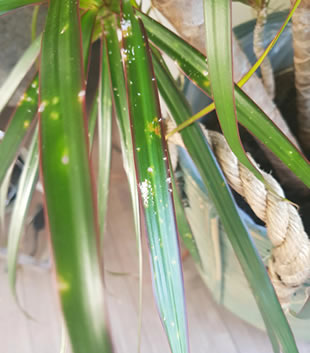
Effective ways of eliminating pests from your plant
Usually a good quality pesticide or high grade neem oil spray will be enough to get rid of these unwanted guests that are feeding on your plant.
Luckily though, repotting and root management is usually unnecessary with dracaena as pest problems on houseplants are usually picked up early simply because the plant’s are in our line of sight more often than outdoor plants.
In some extreme cases you may also need to treat the roots of the plant and repot the dracaena in a new container with fresh soil if your plant has been attacked by root-eating pests. If the pests have burrowed down into the soil and started to feed on the roots you will need to follow the advice given earlier for treating root rot as well as applying pesticide and repotting your plant.
Having said that, you would need to be very unlucky indeed as the good news is that root-killing pests such as weevils rarely feed on dracaena. It is just something to be aware of.
5. Old age – death comes to us all
We live in a world were everything dies. Your dracaena could be dying simply because it is old.
Although dracaena can live much longer than many other common houseplants it still has an expiry date.
Many houseplants will live between 2 – 5 years but you can expect to get at least a decade out of your dracaena. If you have been giving an aging plant the best of care and tried all the fixes above with no success then your dracaena may just be too old to continue.
A cool way to ensure your dracaena cheats death
It is a good ideas to take a cutting from an old dracaena and propagate a new plant from it.
Propagation is also a good idea if you find that your dracaena is beyond treatment and is doomed to die through either excessive disease damage or root rot.
Follow the advice outlined in the article how to root dracaena for an easy way to cultivate a new dracaena from your existing plant.
The same 5 common problems also cause dracaena leaves to fall off
Below are the 5 things that can cause dracaena leaves to fall off the plant:
- Overwatering.
- Incorrect light.
- Overfertilization.
- Temperature stress.
- Pest attacks.
- Disease.
For information on identifying which of the 5 causes is responsible for the loss of foliage on your dracaena plant, and their treatments, please read the above sections of this article.
This is by far the most common cause for dracaena leaves dying
So the question is “why are the leaves dying on your dracaena?”.
The most common cause for dracaena leaves dying is overwatering the plant. However, incorrect light, overfertilization, temperature stress, pest attacks and disease can all cause a dracaena to shed its foliage.
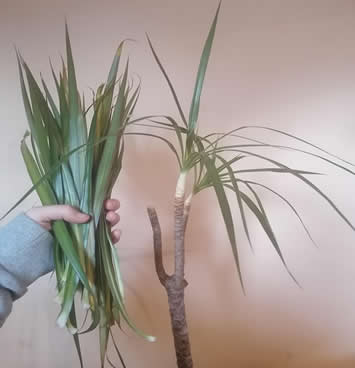
It is imperative you identify which particular cause is responsible for causing so much stress to your dracaena that it is shedding leaves. Only then can you apply the cure.
To identify and treat your plant for foliage loss you will want to follow the advice in our article how to regrow dracaena leaves.
Let it go – knowing when you’ve tried hard enough to save the plant
Sometimes it doesn’t matter how hard we try or how many times we try it; there are times when there is nothing you can do to change a situation.
You may find that after all your efforts your dracaena plant does not recover.
The simple truth is – you cannot revive a dead plant.
However, sometimes a dracaena will look dead due to foliage loss, when it is just seriously distressed. So, it is always a good idea to take action steps to try to revive your plant.
Only by inspecting the roots can you be sure the plant is actually dead. If there are still even a few healthy roots on the dracaena then it is likely you can revive the plant.
If your plant has lost all its foliage and the main stem and offshoots are dry and brittle then the plant is most probably dead. However, the plant may not necessarily be beyond saving just because it looks dead. There may still be living roots underneath the soil.
Follow the advice in our article on dracaena root rot for instructions on inspecting the roots and treating the plant. If it still has even a few healthy roots left you will most likely be able to save it with the correct care.
Before you revive your plant, or even propagate a new one, be aware that dracaena is poisonous (this includes the very popular dragon tree) and if you have pets they may be at risk from this succulent.
You may also be interesting in our article how to make lemon lime dracaena bushier as the advice it contains can be applied to any dracaena species.

